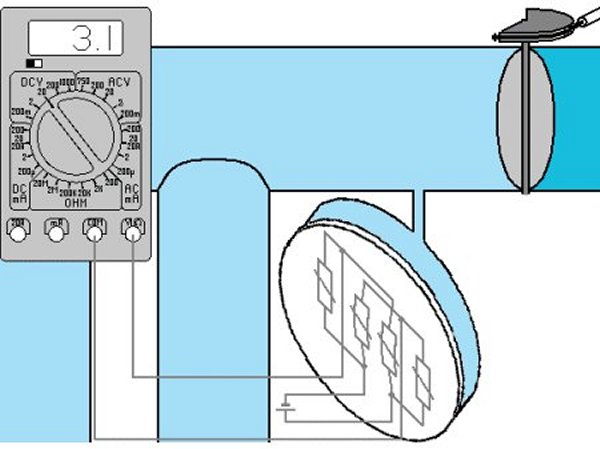|
Pressure Sensor
Assignment
As a Manifold Absolute Pressure-sensor, it measures the pressure in the inlet manifold compared with the ambient pressure. Thereby, it can replace the
air-volume-sensor. However, it can also be installed, e.g., as a height corrector together with the air-volume-meter and thus be used to measure the ambient pressure. In this case, it must not necessarily be
installed in the near vicinity of the engine. If it is placed in a distant corner however, it can easily be overlooked when searching for the error.
Function
A bridge circuit is fed with a voltage supply. Two of the strain-gauges are in a wafer-thin membrane of silicon crystal more towards the center, another two are moved more to the edge. They bend under higher
pressure and provide the inside ones with an increase, and the outside ones with a decrease in resistance. Should the signal be amplified, then a pretty well resolved voltage between 0 and 5 arises.

In conventional engines (without any turbo support), The total pressure area lies distinctly below or slightly above 1 bar, in turbo-engines it can amount to up to 2 bar and even more. Should a person suck strongly on
the - closed to all sides - inlet manifold, even that can generate a significant change in the signal. Instead of the multimeter (see picture) of course an oscilloscope (preferably) can also be used. In the casing of the
pressure sensor by the way, a temperatur sensor can also be housed.
Workshop
The pressure sensor transmits a load signal to the control device. As soon as the Lambda sensor kicks in and e.g., no acceleration takes place, the control device could manage without the signal from the pressure
sensor. Should however, the accelerator pedal be pressed, then it needs a value above it's expressed marking. Since it must decide on the amount of the enriching. With a central
injection (SPI) there is only one throttle-flap potentiometer and no MAP-sensor at all. In Multipoint systems (MPI) the two often
function together. However, should either one start to play up, the result can be that the vehicle has a jerky accelration. In this case, one should tow the vehicle away (or have it towed), because it is then a danger to the
safety of other traffic. In general, the importance of the good control behaviour of our vehicles is, sadly, underestimated. We have become used to the fact, that giving minimum gas results in minimum acceleration.
The manufacturers apply a great deal of brain-power, to supply the engine, particularly in the low RPM area, with the torque that the customer expects from his/her vehicle, an important factor for the attachment to the
car.
In general
For the last 40 years the requirements of the motor-industry, as far as sensors are concerned, have been growing. If these were, at first, designed for various industrial applications like e.g., the manufacturers of
pressure sensors, the vehicle sector is now being served with very special solutions. This of course, is due to the high production amounts, the pressure of expenses as well as the renewal tempo, which rules here.
In addition, there is also the distinct trend towards size reduction, which is thus, accompanied by weight reduction. Silicon has been joined by quartz, which with its Piezo effects, is exceptionally well suited for the
measuring of pressure. Furthermore, by intalling additional micro-chips, the sensors are given a certain amount of intelligence, which enables either the preparation of measurement values or also, e.g., the
participation in a LIN-Bus. 02/11
|
|